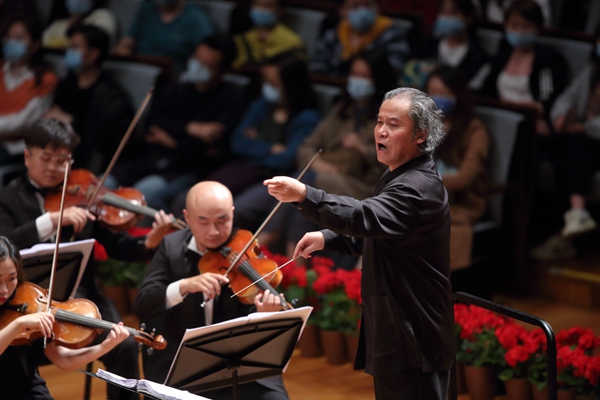

Orchestra festival highlights determination of rural ensemble to popularize classical works, Chen Nan reports.
The National Center for the Performing Arts staged its annual China Orchestra Festival from April 8 to May 7, presenting 21 concerts, featuring 22 symphony orchestras from 14 provinces in the country.
The Sichuan Liangshan Mountain Symphony Orchestra made its debut performance at the NCPA on May 3, featuring music pieces by Chinese composers, such as Song and Dance on the Hill by Tang Qingshi, violin concerto The Butterfly Lovers by He Zhanhao and Chen Gang, as well as the symphonic suite Warm Mountains by Chang Yingzhong, Yang Xiaozhong, Yang Hua and Song Mingzhu.
Unlike many other symphony orchestras participating in the festival, the ensemble, which is based in the Daliangshan Mountain area of Liangshan Yi autonomous prefecture in Xichang, Sichuan province, routinely holds outdoor concerts, with the mountain as a backdrop, rather than performing in concert halls.
Over the past eight years, as the only professional symphony orchestra in the region, the Sichuan Liangshan Mountain Symphony Orchestra, led by its conductor and musical director Tang Qingshi, has been defying challenges to bring classical music to the local people, who are mostly from the Yi ethnic group.
By offering free concerts every weekend, classical music has found an unlikely fan base in the Daliangshan Mountain area.
"The local people have lived in the mountainous area for generations and are far from urban centers. They grew up listening and singing folk songs in the local dialect," says Tang. "However, we are proud to see that a greater number of people are attending our concerts, and that some of them have even become classical music fans."
So far, the orchestra has performed nearly 600 concerts, which have attracted audiences totaling 600,000 people.
Yet, running such an orchestra in a mountainous area like Daliangshan is no easy task.
Tang graduated from the Shanghai Conservatory of Music in 1984 with a major in conducting, and worked with the symphony orchestra of Sichuan's Emei Film Group-one of the nation's seven film groups and the largest in Southwest China in the 1990s. He traveled to the Daliangshan Mountain area many times to record local folk songs, which allowed him to learn about the local culture.
In 2002, he was transferred to work at the Sichuan Symphony Orchestra and led the orchestra to perform in the Daliangshan Mountain area many times.
In 2010, Liu Kang, one of the directors of the Liangshan Song and Dance Troupe, initiated a series of classical music concerts, hoping to develop a local audience for the Western art form. In 2013, Tang was invited to head the newly founded Sichuan Liangshan Mountain Symphony Orchestra.
One of the biggest challenges for Tang, however, was a dearth of trained musicians.
"Recruiting orchestra members is still a problem for us today, though the situation is getting better, with locals gradually opening up to classical music," says Tang, adding that a professional symphony orchestra usually has about 80 musicians, but the Sichuan Liangshan Mountain Symphony Orchestra currently performs with just 50.